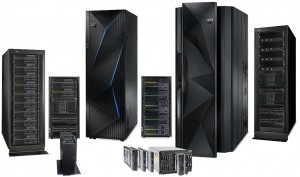So why is hardware important for OpenStack? Apple builds great products having control over the entire stack for consumers, including the iPad and iPhone, and Microsoft has also recently delivered similar products like Surface Pro. Large IT vendors like Cisco, HP, IBM and Oracle are delivering integrated hardware and software stacks to reduce complexity for their customers. Open standard software is a rage with start-ups leveraging cloud computing, and enterprises are also contemplating open solutions consisting of an end-to-end stack.
Here is a short table comparing System z & Power Systems on some aspects important to enterprise customers:
| Private Cloud | Public Cloud | Security | Community development | |
| System z | Very applicable | Limited use | Very strong | Not shared |
| Power Systems | Applicable | Optimum use by partners | Strong | IP licensed to others through OpenPower |

Below are four primary IT components delivered on IBM hardware:
-
-
- Compute: Scaling compute power to meet unexpected usage spikes has been an eternal challenge to enterprises. Power Systems virtualization management with PowerVC and server virtualization with PowerVM, and z/VM mainframe virtualization allows IBM to automate these tasks through a programmable infrastructure. OpenStack Compute (Nova) APIs can leverage PowerVM & z/VM to have complete access of the underlying compute resources through a virtual management console. Both Power Systems and System z have robust attributes like VM placement and isolation that delivers an extra level of security within the compute infrastructure.
- Network: Currently network administration capability is woefully inadequate to help customers respond to fast-changing market needs e.g. a sudden surge in interest of a commerce application. Controlling network assets using software reduces human intervention while meeting rapidly changing network capacity needs. Building connections from OpenStack Networking (Neutron) to various switches in both the Power Systems and System z platform can allow customers to automate connectivity and optimize network resources.
- Storage: With the astonishing growth of data from mobile and social channels, enterprises face significant challenges to managing storage. Flash is increasingly becoming a way to optimize delivery of data to customers by shuffling information between traditional and flash storage resources. Using a common interface from OpenStack Object and Block Storage (Swift and Cinder), users can develop rules to optimize use of storage depending on service level agreements. IBM’s software defined storage(SDS) strategy includes contributing heavily to OpenStack Cinder, and enabling it to control IBM and non-IBM storage thereby bringing together traditional and new delivery models.
- Security: Security is one of the biggest barriers to enterprise cloud adoption. While IBM’s recent licensing of ARM processors has been positioned as a play for custom chip clients, a bigger benefit would be to build cloud security into the network. IBM has the capability to develop and deliver a secure hybrid cloud solution by combining System z and Power Systems in the data center with public cloud resources from the recently acquired SoftLayer.
-
Other observations:
-
-
- IBM has capabilities from their software organization, like Tivoli Orchestrator (OpenStack Heat), to manage non-IBM resources for a cross-cloud or hybrid cloud implementation.
- The decision to license IBM Power technology to Google and NVIDIA (both initial members of the OpenPower Consortium) gives IBM an added value of pooling efforts into product development. This could bode well in increasing adoption of Power technology for cloud applications.
- Power Systems Solution Edition for Service Providers could be an offering that grows cloud implementations with the help of managed service providers.
- IBM’s portfolio of hardware offerings plays well with community support from both OpenStack as well as the OpenPower movement. The only challenge for IBM is HP, the other hardware OpenStack platinum founding member, who can offer similar capabilities.
-
OpenStack is primarily considered a software play and very little attention is paid to supporting hardware. With OpenStack administration API’s controlling infrastructure, you will see hardware vendors provide differentiated solutions.
At Enterprise 2013, IBM showed a broad portfolio of System z and Power Systems solutions to help customers leverage cloud computing inside and outside their data centers. My opinion is that customers are willing to pay a premium for functionality built into hardware if it meets their needs and integrated software could be the tipping factor.
